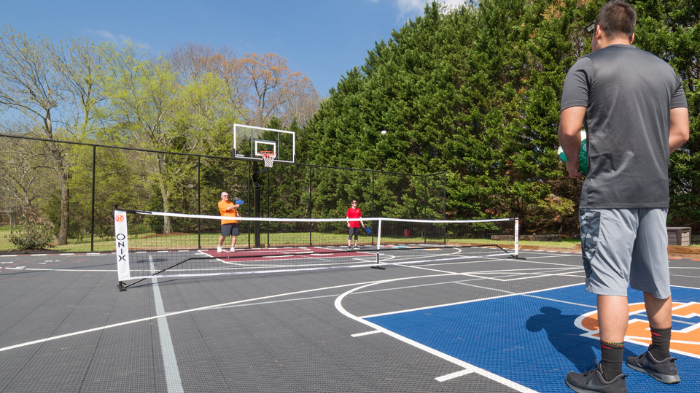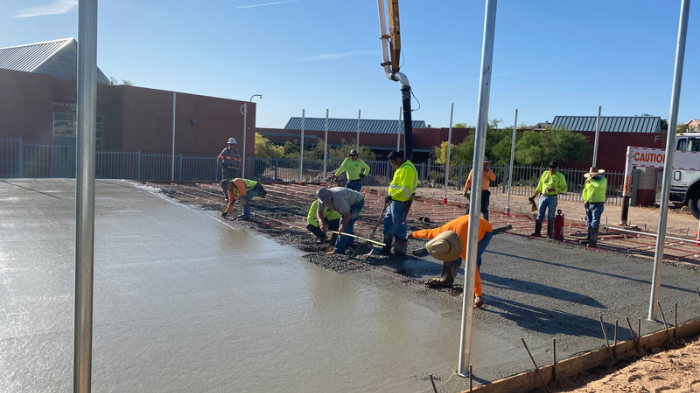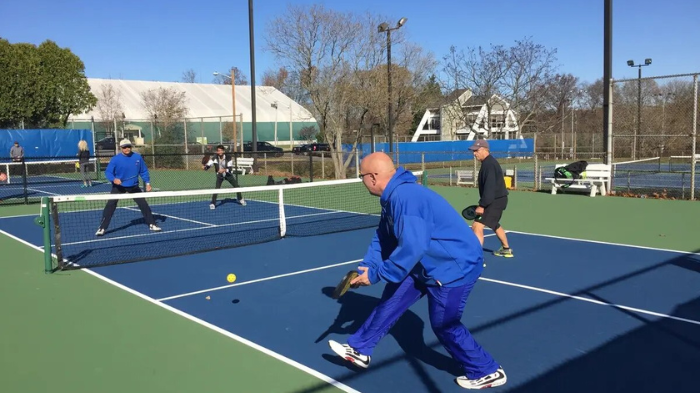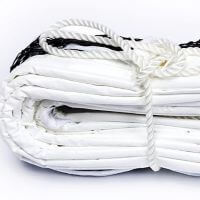Many players wonder if they can play pickleball on a concrete surface, even though it is commonly played on dedicated courts with specific surfaces. In this blog post, we are going to answer the question, “Can you play pickleball on concrete?”.
We are also going to explain why raw concrete is not suitable for playing pickleball through its reasons, the pros and cons of playing pickleball on concrete, how to lay concrete on a pickleball court, the procedure for covering a concrete pickleball court, and what safety measures that players should take when playing pickleball on concrete.
You Might Also Like:
Can Pickleball Be Played On Concrete?
Yes, pickleball can be played on concrete surfaces. In fact, one of the most popular surfaces for pickleball courts is concrete. Concrete is used to construct many outdoor pickleball courts since it is a sturdy and reasonably priced material.
Concrete provides a solid and even playing surface, which is important for playing pickleball. However, it is recommended to use a specialized type of paint or coating on the concrete to create the necessary court lines and provide better traction for players. These lines define the boundaries and non-volley zone (kitchen) areas of the court.

If you want to play pickleball on a concrete surface, you can mark the court lines by utilizing pickleball court stencils and applying suitable paint or court tape. This practice guarantees the accurate establishment of court dimensions, enabling the game to be played in accordance with the standard rules. By employing these methods, players can ensure a properly marked court that meets the necessary specifications for a fulfilling pickleball experience.
Pros and Cons of Playing Pickleball on Concrete Surfaces
Playing pickleball on concrete surfaces has its own set of advantages and disadvantages. Here are some pros and cons to consider:
Pros:
- Durability: Concrete is renowned for its exceptional durability, enabling it to withstand regular usage and challenging weather conditions. This makes it an ideal choice for constructing pickleball courts that are designed to last for an extended period.
- Accessibility: Concrete courts are conveniently accessible and extensively utilized, allowing players in diverse locations to easily locate and enjoy them.
- Affordability: Concrete is a relatively inexpensive material, making it a cost-effective option for constructing pickleball courts, especially in outdoor settings.
- Even Playing Surface: Concrete provides a solid and even playing surface, ensuring consistent ball bounce and predictable gameplay.
Cons:
- Hard Impact: Concrete surfaces are harder than other court surfaces, resulting in increased impact on players’ joints, especially during quick movements and abrupt stops.
- Reduced Shock Absorption: Concrete has minimal shock absorption properties, potentially leading to increased strain on players’ muscles and joints over time.
- Potential Slip Hazards: When concrete surfaces get wet, they can become slippery, posing a higher risk of slips and falls. This is especially important to note during outdoor pickleball attack games, especially when there is rain or moisture present.
- Lack Of Cushioning: The hard nature of concrete may lack the cushioning effect provided by other surfaces like asphalt or rubber, potentially causing discomfort during extended play sessions.
Why It Is Not Suitable to Play Pickleball on a Raw Concrete?
Playing pickleball on raw concrete is generally not suitable for a few reasons:
Surface Hardness: Raw concrete surfaces are typically very hard and unforgiving. The lack of surface absorption on raw concrete causes the ball to bounce with minimal cushioning, making it challenging to control the trajectory and speed of the ball. It can also lead to increased strain on joints, particularly in the ankles, knees, and hips, which may result in injuries like fractures or joint pain.
Lack Of Cushioning: Playing on concrete surfaces can be problematic because they don’t have cushioning properties. This means that if players fall or dive while playing, they can experience a strong impact that may result in injuries. This lack of shock absorption is particularly problematic for older players or individuals with joint issues.
Slippery Surface: Concrete surfaces can become slippery, especially when they are wet. This poses a danger as players are at risk of slipping, falling, or twisting their ankles. In the game of pickleball, where players often make rapid side-to-side movements and frequently change directions, a slippery surface significantly increases the chances of accidents and injuries.
Ball Responsiveness: Pickleball is a game that requires precise control and accuracy. Raw concrete surfaces do not allow the ball to respond like dedicated pickleball courts or other appropriate playing surfaces. On raw concrete surfaces, the ball tends to slide or skid instead of bouncing consistently, which negatively impacts the quality of the game and reduces the enjoyment for players.
Longevity Of Equipment: Playing pickleball on raw concrete can cause increased wear and tear on paddles, balls, and even shoes. The abrasive nature of the concrete can damage the equipment more quickly than on appropriate playing surfaces. This can result in increased expenses for replacing or repairing equipment more frequently.
Overall, playing pickleball on raw concrete is not ideal due to the hard, unforgiving surface, lack of cushioning, potential for slips and falls, reduced ball responsiveness, and increased equipment wear. To fully enjoy the game and ensure player safety, it is recommended to play on proper pickleball courts or other suitable playing surfaces designed specifically for the sport.
Procedure for Laying Concrete on a Pickleball Court
To lay concrete on a pickleball court, you’ll need to follow a specific procedure. Here are the general steps involved:
Prepare The Site: Start by clearing the area where the pickleball court will be located. Remove any vegetation, rocks, or debris. Ensure that the ground is level and compacted.
Mark The Court Dimensions: Use measuring tape and stakes to mark the dimensions of the court. A standard pickleball court measures 20 feet wide by 44 feet long for doubles play or 20 feet wide by 22 feet long for singles play. Double-check your measurements to ensure accuracy.
Excavation: Dig out the marked area to a depth of about 4 to 6 inches. Remove the excavated soil and set it aside for later use or disposal. Make sure the excavation is uniform throughout the entire court area.
Install A Gravel Base: Spread a layer of crushed gravel or road base material over the excavated area. Compact the gravel using a vibrating plate compactor or a roller. The base should be well-compacted and provide a stable foundation for the concrete.
Install Forms: Set up wooden or metal forms along the edges of the court to create a barrier that will contain the concrete. Ensure that the forms are level and securely in place. Use stakes and nails to secure the forms to the ground.
Reinforcement: Place reinforcement mesh or rebar within the forms to provide additional strength to the concrete. This step is optional, but it can help prevent cracking and improve the longevity of the court.
Pouring The Concrete: Order ready-mix concrete from a local supplier. Start pouring the concrete into the court area, starting from one end and working your way to the other. Use a concrete pump or wheelbarrows to transport and pour the concrete. Spread the concrete evenly using shovels, rakes, or a screed board.

Leveling And Finishing: Use a bull float or a large magnesium float to level the concrete surface. Move the float back and forth in a sweeping motion to remove any high spots and fill in any low areas. If desired, you can apply a broom finish by dragging a stiff-bristle broom across the surface to create texture for better traction.
Curing: Cover the freshly poured concrete with a plastic sheet or use a curing compound to retain moisture and promote proper curing. Follow the manufacturer’s instructions for the curing compound application. Allow the concrete to cure for at least 7 days before using the court.
Court Markings: Once the concrete is fully cured, you can paint the court lines according to the official pickleball court specifications. Use high-quality, non-slip paint and stencils to mark the boundaries, baselines, sidelines, and centerlines.
It is crucial to check local building codes, regulations, and the guidelines provided by the governing pickleball organization in your area before covering a concrete pickleball court. This will help you to ensure that you meet all the necessary requirements and accurately adhere to the recommended court dimensions.
Also Read About: Best pickleball communities And penhold grip in pickleball
How to Cover a Concrete Pickleball Court?
Covering a concrete pickleball court involves several steps to ensure a suitable playing surface. Here is a guide on how to cover a concrete pickleball court:
Clean The Court: Begin by thoroughly cleaning the concrete surface to remove any dirt, debris, or loose materials.
Repair Any Damages: Inspect the court for any cracks, chips, or uneven areas. Repair these damages using appropriate methods, such as filling cracks or resurfacing damaged sections.
Choose The Covering Material: Select a specialized surface material suitable for pickleball courts. Popular options include acrylic coatings, rubberized surfaces, or synthetic turf. Consider factors such as durability, traction, and shock absorption.
Prepare The Surface: Before applying any covering material, it is important to prepare the concrete surface properly. Make sure that the concrete is clean, dry, and ready according to the instructions provided by the manufacturer for the chosen material. This may include applying a primer or leveling compound as required.
Install The Covering Material: Follow the manufacturer’s guidelines to install the chosen covering pickleball court surface material. This typically involves rolling out the material, adhering or securing it to the concrete, and ensuring proper alignment and tension.
Allow Curing Time: Depending on the type of covering material used, allow sufficient time for it to cure and bond to the concrete. Follow the manufacturer’s recommendations for curing time before allowing regular play on the court.
Maintain And Clean The Surface: Regularly maintain and clean the covered pickleball court to ensure optimal performance and longevity. This may involve periodic sweeping, pressure washing, or applying specialized cleaning solutions.
By following these steps, you can effectively cover a concrete pickleball court, transforming it into a suitable playing surface for pickleball while enhancing player comfort and safety.
Safety Measures to Take When You Play in a Concrete Pickleball Court
When playing in a concrete pickleball court, it is important to prioritize safety to minimize the risk of injuries. Here are some safety measures you should take:
Proper Footwear: Wearing the right footwear specifically designed for court sports is crucial when playing on a concrete pickleball court. These shoes should have non-marking soles that provide exceptional traction on the concrete surface, significantly reducing the likelihood of slipping or sliding while playing the game.

Warm-Up And Stretching: Before starting the game, it is essential to engage in a thorough warm-up routine that includes stretching exercises. This not only prepares your muscles and joints for physical activity but also helps reduce the risk of strains or sprains during gameplay.
Court Inspection: Inspect the court for any hazards or obstacles, such as cracks, uneven surfaces, or debris. Report any issues to the appropriate authorities to ensure whether the court is safe to play pickleball or not.
Use Protective Gear: If you have a history of joint problems or previous injuries, it is highly recommended to wear protective gear such as knee pads, elbow pads, or wrist guards. These accessories offer added protection and support to your joints, which reduces the risk of re-injury or aggravating existing conditions.
Avoid Excessive Force: When you play on a concrete court, it is crucial to be mindful of how your shots can affect your body. To minimize the risk of strains or injuries, it is advised to avoid using excessive force and prioritize the use of proper techniques while maintaining control when playing on a concrete court.
Fall Prevention: Concrete surfaces can be hard, so it is crucial to be mindful of your movements and balance. Avoid sudden stops or changes in direction that may lead to falls. If you feel unstable, it is advisable to try to regain your balance or take a controlled step rather than taking the risk of falling.
FAQs
You can cover a concrete pickleball court with a specialized surface, which can enhance gameplay and increase safety by reducing the chances of injuries. It is crucial to recognize that covering the court is not obligatory, and some players may still prefer playing on the original concrete surface.
While playing pickleball on concrete is feasible, it can exert more pressure on your joints due to the lack of cushioning. To ensure safety, it is important to take necessary precautions, wear appropriate footwear, and be mindful of the condition of the playing surface.
Yes, you can lay concrete to create a dedicated pickleball court. By adhering to the correct procedures and dimensions, it is possible to create a well-designed court that will be suitable for playing pickleball.
Although concrete courts are commonly chosen, it is important to note that pickleball can be played on different surfaces, such as asphalt, tennis courts, or even indoor gym floors with appropriate adjustments and modifications.
Regular cleaning, repair of any damages, and addressing issues promptly can help to maintain a concrete pickleball court. Furthermore, it is crucial to ensure proper maintenance of the chosen covering material, if applied, to keep the pickleball court surface in good condition.
Conclusion
Can you play pickleball on concrete? Yes, you can play pickleball on concrete, but you have to follow the safety measures mentioned in this blog. Make sure that you don’t play pickleball on a raw concrete court as it’s surface is very hard and slippery, it has no cushioning features, does not allow your ball to respond effectively like other dedicated pickleball courts, reduces the longevity of your pickleball equipment.
Enhancing your pickleball playing experience and ensuring safety can be achieved by either layering concrete on your pickleball court or covering it with an alternative surface. When deciding whether to layer concrete on your pickleball court or cover it with an alternative surface, it is important to consider your budget and personal preferences.






